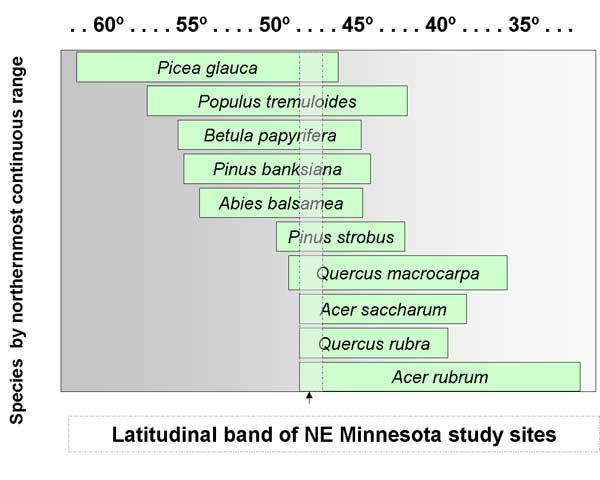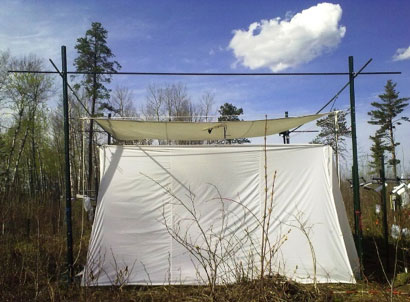Anthropogenic climate change will likely result in shifts in tree species ranges and abundances. The species composition of the southern boreal biome (much of northern USA and southern Canada) is expected to be especially sensitive to climate warming since there is a relatively sharp boundary between many temperate species to the south and boreal species to the north. The potential of climate warming to alter tree species composition at the southern boreal-temperate forest ecotone is being assessed in a number of experiments, including research in experimentally warmed plots at two forested sites in northern Minnesota as part of a project called B4WARMED (Boreal Forest Warming at an Ecotone in Danger).
Funded by:
U.S. Department of Energy, Grant No. DE-FG02-07ER64456
University of Minnesota
Environment and Natural Resources Trust Fund
Minnesota Invasive Terrestrial Plants and Pests Center

B4WARMED: Boreal Forest Warming at an Ecotone in Danger.
The Principal Investigators are Peter Reich (PI), Rebecca Montgomery, Sarah Hobbie, Jacek Oleksyn and Roy Rich (co-investigators). The research seeks to help answer the question, "How will Minnesota tree species respond to a warming climate?"
The global climate system is being altered by anthropogenic emissions of CO2 and other greenhouse gases, increasing temperatures worldwide, particularly at northern latitudes. The pace of global climate change, including warming, is expected to accelerate in the coming century, as atmospheric concentrations of greenhouse gases continue to increase. In Minnesota, our climate has migrated 70 miles north in the past 50 years, and may migrate 125-250 miles further north in the next 50 years.
Northern Minnesota is a focal point of potential climate warming impacts because it sits at the transition – or ecotone- between the boreal and temperate forest zones. Most tree species in these forests (like aspen, spruce, and birch) are common in the boreal forests to our north in Canada or in the temperate maple-oak forests common to Wisconsin and places south and east. Increasing oak-maple dominance in our forest communities under a warmer future would represent a shift from our boreal heritage. However, both the northern and temperate tree species may perform poorly under warmer conditions. If so, neither our current forest trees nor their potential replacements may be well suited to our future climate. This experiment will enable us to assess the potential for climate change to alter future forest composition by experimentally warming forest plots (with infrared lamps and soil heating cables). We are documenting the effects on establishment, growth, and survival of seedlings of ten important tree species near their warmer (boreal species: Pinus banksiana, Picea glauca, Abies balsamea, Populus tremuloides, Betula papyrifera) or colder (temperate species: Pinus strobus, Quercus macrocarpa, Quercus rubra, Acer rubrum, Acer saccharum) range limits in northern Minnesota, in order to understand how germination, growth and survival at the establishment stage are influenced by direct and indirect climate effects.

Our central hypothesis is that warming treatments will enhance growth and survival of temperate species at the cold (northern) edge of their range but reduce growth and survival of boreal species at the warm (southern) edge of their range.
Research sites are located at the Cloquet Forestry Center, near Cloquet, MN and at the Hubachek Wilderness Research Center near Ely, MN.
To date, we have achieved temperature elevation near our targets. Warmed season means across 2009-2012 field seasons were +1.9C and +3.5C for soil temperature at 10 cm depth. Aboveground means were +1.6C and +3.3C from infrared radiometer measurements of canopy surface temperature.

In 2012, we installed and deployed event-based rain exclosures on 18 plots in the open canopy replicates of the warming experiment where we could safely and reliably remove rainfall without complications from tree damage to shelters and stem flow from large trees. Mean rainfall exclusion from June until September was approximately 42-45% at both sites.

Growth and survival patterns across the 2008-2012 have been consistent with hypotheses. Boreal species, especially conifers, tended to show negative responses to warming for survival and growth of juveniles whether from the planted seeding or planted seed cohorts (of different ages) or both. Balsam fir and white spruce tended to have the most negative responses. Temperate broadleave species (oak and maples) by contrast tended to have neutral or positive growth and survival responses. Such responses are consistent with in situ photosynthesis responses. Additionally, rising temperatures can affect plant performance indirectly by increasing nutrient availability in soil via accelerating microbial activities. Both shoot and root biomass were significantly increased in soils from the warmed soils; however, significant differences were mainly found between ambient and +3.4 °C temperature treatments. This is a clear indication that warming treatment modified soil processes in significant ways.
This research is supported by the Office of Science (BER), U.S. Department of Energy, Grant No. DE-FG02-07ER64456.
Publications:
2018
Berini, J. L., Brockman, S. A., Hegeman, A. D., Reich, P. B., Muthukrishnan, R., Montgomery, R. A., & Forester, J. D. (2018). Combinations of abiotic factors differentially alter production of plant secondary metabolites in five woody plant species in the boreal-temperate transition zone. Frontiers in plant science, 9.
Mucha, J., Peay, K. G., Smith, D. P., Reich, P. B., Stefański, A., & Hobbie, S. E. (2018). Effect of simulated climate warming on the ectomycorrhizal fungal community of boreal and temperate host species growing near their shared ecotonal range limits. Microbial ecology, 75(2), 348-363.
Reich, P. B., Sendall, K. M., Stefanski, A., Rich, R. L., Hobbie, S. E., & Montgomery, R. A. (2018). Effects of climate warming on photosynthesis in boreal tree species depend on soil moisture. Nature, 562(7726), 263.
Rice, K. E., Montgomery, R. A., Stefanski, A., Rich, R. L., & Reich, P. B. (2018). Experimental warming advances phenology of groundlayer plants at the boreal‐temperate forest ecotone. American journal of botany, 105(5), 851-861.
Thakur, M. P., Reich, P. B., Hobbie, S. E., Stefanski, A., Rich, R., Rice, K. E., ... & Eisenhauer, N. (2018). Reduced feeding activity of soil detritivores under warmer and drier conditions. Nature climate change, 8(1), 75.
Wright, A. J., Fisichelli, N. A., Buschena, C., Rice, K., Rich, R., Stefanski, A., ... & Reich, P. B. (2018). Biodiversity bottleneck: seedling establishment under changing climatic conditions at the boreal–temperate ecotone. Plant ecology, 219(6), 691-704.
2017
Fernandez, C. W., Nguyen, N. H., Stefanski, A., Han, Y., Hobbie, S. E., Montgomery, R. A., ... & Kennedy, P. G. (2017). Ectomycorrhizal fungal response to warming is linked to poor host performance at the boreal‐temperate ecotone. Global change biology, 23(4), 1598-1609
Martins, C. S., Nazaries, L., Delgado‐Baquerizo, M., Macdonald, C. A., Anderson, I. C., Hobbie, S. E., ... & Singh, B. K. (2017). Identifying environmental drivers of greenhouse gas emissions under warming and reduced rainfall in boreal–temperate forests. Functional ecology, 31(12), 2356-2368.
O'sullivan, O. S., Heskel, M. A., Reich, P. B., Tjoelker, M. G., Weerasinghe, L. K., Penillard, A., ... & Bahar, N. H. (2017). Thermal limits of leaf metabolism across biomes. Global Change Biology, 23(1), 209-223.
Schwarz, B., Barnes, A. D., Thakur, M. P., Brose, U., Ciobanu, M., Reich, P. B., ... & Eisenhauer, N. (2017). Warming alters energetic structure and function but not resilience of soil food webs. Nature climate change, 7(12), 895.
Thakur, MP, PB Reich, C Wagg, NA Fisichelli, M. Ciobanu, SE Hobbie, RL Rich, A Stefanski, N Eisenhauer. 2017. Effects of soil warming history on the performances of congeneric temperate and boreal herbaceous plant species and their associations with soil biota. J Plant Ecology 10(4): 670-680, doi: 10.1093/jpe/rtw066
Wei, X., Sendall, K. M., Stefanski, A., Zhao, C., Hou, J., Rich, R. L., ... & Reich, P. B. (2017). Consistent leaf respiratory response to experimental warming of three North American deciduous trees: a comparison across seasons, years, habitats and sites. Tree physiology, 37(3), 285-300.
2016
Carey, J. C., Tang, J., Templer, P. H., Kroeger, K. D., Crowther, T. W., Burton, A. J., ... & Jiang, L. (2016). Temperature response of soil respiration largely unaltered with experimental warming. Proceedings of the National Academy of Sciences, 113(48), 13797-13802.Crowther, TW, KEO Todd-Brown, CW Rowe, WR. Wieder, JC Carey, MB Machmuller, BL Snoek, S Fang, G Zhou, SD Allison, JM Blair, SD Bridgham, AJ Burton, Y Carrillo, PB Reich, JS Clark, AT Classen, FA Dijkstra, B Elberling, BA Emmett, M Estiarte, SD Frey, J Guo, J Harte, L Jiang, BR Johnson, G Kröel-Dulay, KS Larsen, H Laudon, JM Lavallee, Y Luo, M Lupascu, LN Ma, S Marhan, A Michelsen, J Mohan, S Niu, E Pendall, J Peñuelas, L Pfeifer-Meister, C Poll, S Reinsch, LL Reynolds, IK Schmidt, S Sistla, NW Sokol, PH Templer, KK Treseder, JM Welker, MA Bradford. 2016. Quantifying global soil carbon losses in response to warming. 2016. Nature 540:104-108. doi:10.1038/nature20150
Heskel, M. A., O’Sullivan, O. S., Reich, P. B., Tjoelker, M. G., Weerasinghe, L. K., Penillard, A., ... & Sinca, F. (2016). Convergence in the temperature response of leaf respiration across biomes and plant functional types. Proceedings of the National Academy of Sciences, 113(14), 3832-3837.
Heskel, M. A., Atkin, O. K., O’Sullivan, O. S., Reich, P., Tjoelker, M. G., Weerasinghe, L. K., ... & Xiang, J. (2016). Reply to Adams et al.: Empirical versus process-based approaches to modeling temperature responses of leaf respiration. Proceedings of the National Academy of Sciences, 113(41), E5996-E5997.
McCulloh, K. A., Petitmermet, J., Stefanski, A., Rice, K. E., Rich, R. L., Montgomery, R. A., & Reich, P. B. (2016). Is it getting hot in here? Adjustment of hydraulic parameters in six boreal and temperate tree species after 5 years of warming. Global change biology, 22(12), 4124-4133.
Reich, P. B., Sendall, K. M., Stefanski, A., Wei, X., Rich, R. L., & Montgomery, R. A. (2016). Boreal and temperate trees show strong acclimation of respiration to warming. Nature, 531(7596), 633.
Thakur, M. P., Reich, P. B., Wagg, C., Fisichelli, N. A., Ciobanu, M., Hobbie, S. E., ... & Eisenhauer, N. (2016). Effects of soil warming history on the performances of congeneric temperate and boreal herbaceous plant species and their associations with soil biota. Journal of Plant Ecology, 10(4), 670-680.
Uelmen Jr, J. A., Lindroth, R. L., Tobin, P. C., Reich, P. B., Schwartzberg, E. G., & Raffa, K. F. (2016). Effects of winter temperatures, spring degree-day accumulation, and insect population source on phenological synchrony between forest tent caterpillar and host trees. Forest Ecology and Management, 362, 241-250.
2015
Jacques, M. H., Lapointe, L., Rice, K., Montgomery, R. A., Stefanski, A., & Reich, P. B. (2015). Responses of two understory herbs, Maianthemum canadense and Eurybia macrophylla, to experimental forest warming: Early emergence is the key to enhanced reproductive output. American journal of botany, 102(10), 1610-1624.
Jamieson, M. A., Schwartzberg, E. G., Raffa, K. F., Reich, P. B., & Lindroth, R. L. (2015). Experimental climate warming alters aspen and birch phytochemistry and performance traits for an outbreak insect herbivore. Global change biology, 21(7), 2698-2710.
Reich, P. B., Sendall, K. M., Rice, K., Rich, R. L., Stefanski, A., Hobbie, S. E., & Montgomery, R. A. (2015). Geographic range predicts photosynthetic and growth response to warming in co-occurring tree species. Nature Climate Change, 5(2), 148.
Rich, R. L., Stefanski, A., Montgomery, R. A., Hobbie, S. E., Kimball, B. A., & Reich, P. B. (2015). Design and performance of combined infrared canopy and belowground warming in the B4Warm ED (Boreal Forest Warming at an Ecotone in Danger) experiment. Global Change Biology, 21(6), 2334-2348.
Sendall, K. M., Reich, P. B., Zhao, C., Jihua, H., Wei, X., Stefanski, A., ... & Montgomery, R. A. (2015). Acclimation of photosynthetic temperature optima of temperate and boreal tree species in response to experimental forest warming. Global change biology, 21(3), 1342-1357.
Vanderwel, M. C., Slot, M., Lichstein, J. W., Reich, P. B., Kattge, J., Atkin, O. K., ... & Kitajima, K. (2015). Global convergence in leaf respiration from estimates of thermal acclimation across time and space. New Phytologist, 207(4), 1026-1037.
2014
Eisenhauer, N., Stefanski, A., Fisichelli, N. A., Rice, K., Rich, R., & Reich, P. B. (2014). Warming shifts ‘worming’: effects of experimental warming on invasive earthworms in northern North America. Scientific reports, 4, 6890.
Fisichelli, N., Wright, A., Rice, K., Mau, A., Buschena, C., & Reich, P. B. (2014). First‐year seedlings and climate change: species‐specific responses of 15 North American tree species. Oikos, 123(11), 1331-1340.
Schwartzberg, E. G., Jamieson, M. A., Raffa, K. F., Reich, P. B., Montgomery, R. A., & Lindroth, R. L. (2014). Simulated climate warming alters phenological synchrony between an outbreak insect herbivore and host trees. Oecologia, 175(3), 1041-1049.
Thakur, M. P., Reich, P. B., Eddy, W. C., Stefanski, A., Rich, R., Hobbie, S. E., & Eisenhauer, N. (2014). Some plants like it warmer: increased growth of three selected invasive plant species in soils with a history of experimental warming. Pedobiologia, 57(1), 57-60.
Thakur, M. P., Reich, P. B., Fisichelli, N. A., Stefanski, A., Cesarz, S., Dobies, T., ... & Eisenhauer, N. (2014). Nematode community shifts in response to experimental warming and canopy conditions are associated with plant community changes in the temperate-boreal forest ecotone. Oecologia, 175(2), 713-723.
2012
Brzostek, E. R., Blair, J. M., Dukes, J. S., Frey, S. D., Hobbie, S. E., Melillo, J. M., ... & Stefanski, A. (2012). The effect of experimental warming and precipitation change on proteolytic enzyme activity: positive feedbacks to nitrogen availability are not universal. Global Change Biology, 18(8), 2617-2625.